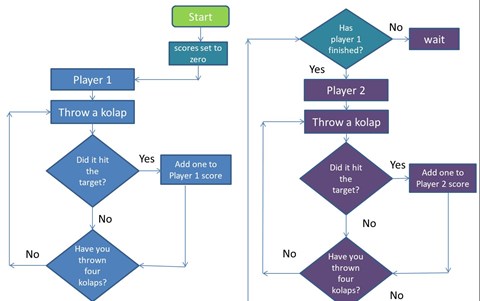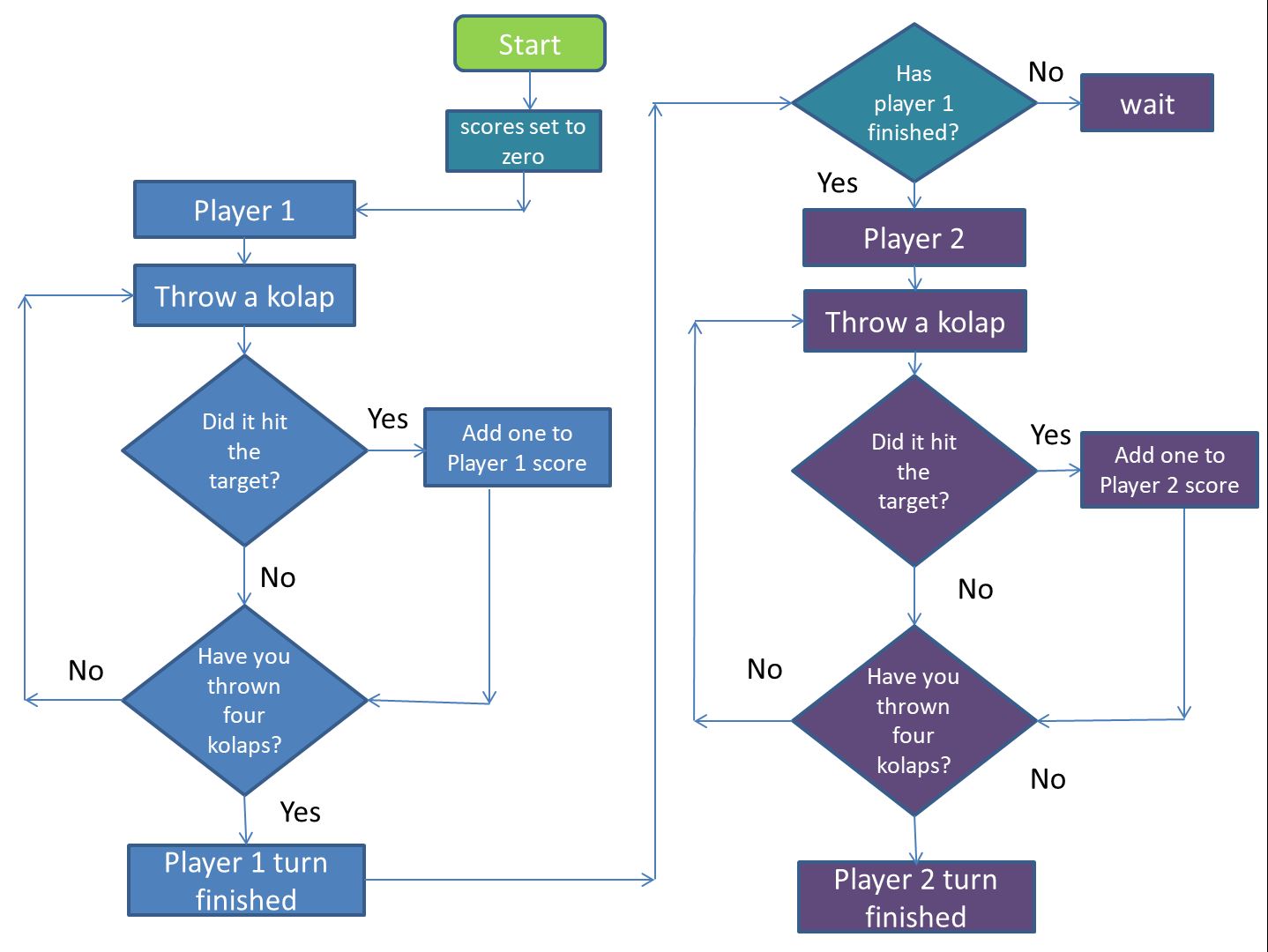Algorithms for First Nations Australian games

About this lesson
In this lesson, we explore algorithms and how they can be used to provide instructions to play a First Nations Australian instructive game. We also learn about aspects of First Nations cultures. This lesson sequence was developed in collaboration with Aboriginal and Torres Strait Islander Mathematics Alliance (ATSIMA).
Year band: 3-4
Curriculum Links AssessmentCurriculum Links
Technologies – Digital Technologies
Years 3-4
Follow and describe algorithms involving sequencing, comparison operators (branching) and iteration AC9TDI4P02
Recognise different types of data and explore how the same data can be represented differently depending on the purpose AC9TDI4K03
Cross Curriculum Priorities
Aboriginal and Torres Strait Islander Histories and Cultures
Culture
First Nations Australians’ ways of life reflect unique ways of being, knowing, thinking and doing A_TSIC2:
Assessment
Achievement standard
By the end of Year 4, students process and represent data for different purposes. They follow and describe simple algorithms involving branching and iteration and implement them as visual programs.
Use this rubric to assess students’ proficiency in creating and following an algorithm.
|
|
1 (limited) |
2 (basic) |
3 (proficient) |
4 (advanced) |
|
Describe simple algorithms involving branching and iteration |
With guidance, demonstrates limited ability to describe or interpret a sequence of steps. |
Interprets the sequence of steps and, with support, identifies an example of branching or repeat steps (iteration). |
Consistently interprets the sequence of steps and identifies decisions (branching) and repeat steps (iteration). |
Demonstrates a high level of accuracy in describing the sequence of steps, predicts outcomes of events, and explains ways to repeat steps including ‘loops’ and ‘repeat until’. |
Learning map and outcomes
- Describe the role of games and toys that have long been used by First Nations Australians.
- Describe ways to provide instructions and rules to play a game.
- Create and follow an algorithm that includes decisions (branching) and repeated steps (iteration).
Preparation
Review the First Nations Australian instructive game Kolap and the slides: Teachers slides: Instructive games.
Video: Kolap This video provides an introduction to kolap and instructions on how to play.
You may want to do a trial run of the game with a fellow teacher or PE specialist before the lesson. When you review, consider if some images might help explain the sequencing of instructions and learning about algorithms. You could take digital photographs or video of the game to incorporate into the discussion and design of algorithms featured in the lesson.
Equipment required:
- mats (softball bases, carpet squares, rubber mats or small towels), one per pair/team, placed between the two players of each team, who stand 5 to 7 metres apart
- beanbags or gum nuts, or similar objects, to represent the kolap beans (4 per pair/team).
Familiarise yourself with advice on ways to connect First Nations Australians’ histories and cultures and the content descriptions covered in this lesson. Read through the Teacher background information: Instructional toys and games.
Learning hook
Explain to students the First Nations Australian instructive game Kolap. Use the Australian Sports Commission poster, digital photographs or videos to demonstrate how the game is played. Have a pair (or two pairs) of students demonstrate the game for the class.
Have students describe the actions of the game and the order of the sequence of instructions. Ask how they would explain the game so that they could teach the game to someone else.
Take the opportunity to discuss the role of games and toys that have long been used by First Nations Australians as instructional devices and models for educational, social and cultural learning.
Learning construction
As a class, read through the instructions for the game Kolap.
Use Kolap, the instructive game that has a long history of being played on Mer Island in the Torres Strait region, to discuss how a game can be represented as an algorithm.
Computational thinking
The first step in developing an algorithm is to use abstraction and focus on the important information. Ask students to pick out the important information and disregard information that is less important. This can be highlighted or circled.
Break the problem down into smaller parts to work out the sequence. Read through the Kolap game instructions, organise information using the students' own words displayed on a chart. To organise ideas, use the headings such as:
- Getting ready
- Score set up
- Player turns and attempts
- Score updates
- Winning score
Next, guide students to think about the key parts of the game, now with instructions that can be written in a sequence of steps with branching (decisions) and repeat steps (iteration).
Identify the ways the instructions could be conveyed, including the use of text and images.
Ask the following:
- How could we represent the game as an algorithm?
- What steps make up the sequence? How does it start? What patterns can you observe? How does the game end?
- What decisions are made? Look for instructions that include the word IF. For example, IF an event or action happens, THEN what happens?
- Are any steps repeated? How might you show that in an algorithm?
To support the process, use the Teachers slides: Instructional games.
Use slides 7-8 to show sample flow charts for students to follow. Using slide 7 have a student role playing player 1 and following the steps. Ask what happens after Player 1 has finished their turn. Write the next steps of the flow chart. Slide 8 shows player 2 steps of having a turn.

Support students to recognise and use the language ‘IF/THEN’ to describe situations where decisions are made. You may use terms such as ‘repeat steps’ or ‘continue until’ to describe instances where iteration can be used.
Learning demo
Students create their algorithm. They may work individually or in pairs.
Let students choose the way they want to represent their algorithm.
- Images and verbal instructions: To reduce cognitive load, some students may use the images taken of the game to verbally describe instructions.
- Images and written instructions: Students may use a combination of images (drawn or digital) combined with steps written on cards or sticky-notes, to create their sequence.
- Flowchart: Some students may draw a flowchart to display the steps in a sequence showing decisions as branching and repeat steps as a loop.
Testing and checking
As students create the algorithm, they can test the sequence by following the steps and then make adjustments to ensure their steps and decisions achieve the expected outcome.
Once the students have completed their algorithm, they could swap with another person/pair and follow the algorithm to see if it achieves the expected outcome. Have them provide constructive feedback on each other’s algorithms. Use a ‘compliment sandwich’ (two good points, one either side of something that could be improved).
Differentiation
Enabling prompts: What are the steps in playing the game Kolap? How can you use images to describe the sequence of steps in the game?
Extending prompts: How might a flowchart be used to provide instructions to play the game? What steps are repeated? What types of decisions are made?
Learning reflection
Provide the opportunity for students to display and share their algorithms. Look at the different ways the game is explained using an algorithm. Summarise the learning and ask students to describe where they can see examples of branching and repeat steps. Revisit what students learned about these traditional First Nations Australian instructive games and the role they play in Australia’s cultural heritage.
Why is this relevant?
In learning about algorithms through Aboriginal and Torres Strait Islander instructive games and toys, students are given the opportunity to deepen knowledge and understanding that helps them make sense of their world. Students can also develop pride and respect for the cultural heritage of such games both from the past and the present and how they are an important part of Australia’s cultural, social and historical record, and an important aspect of the cultural heritage and cultural expressions of Australia (Edwards, 2012, p. 20). For further advice, read through the Teacher background information: Instructional games and toys.
Resources
Teachers Slides - instructional games
First Nations Australian instructive game -Kolap (PDF)
Teacher background information- instructional toys and games
For other traditional games from around Australia, refer to Yulunga Traditional Indigenous Games.
Yulunga means ‘playing’ in the language of the Gamilaroi (also known as GomeroI and Kamilaroi) People of northern-western New South Wales.